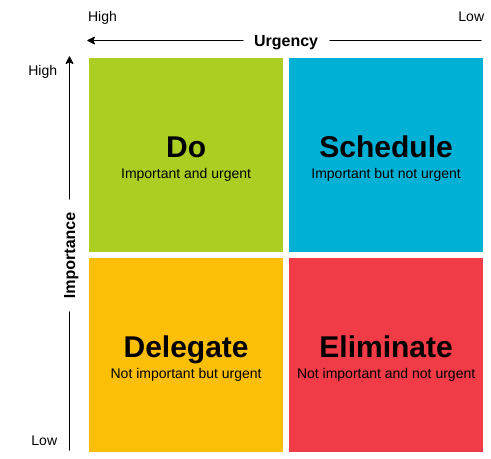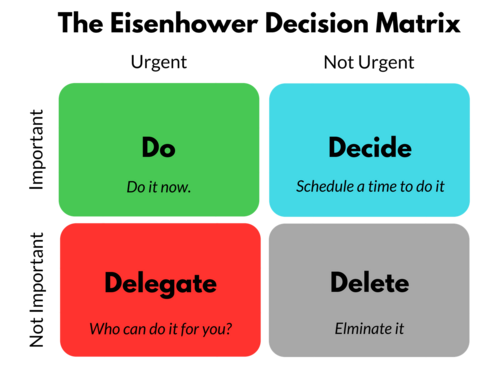Prioritizing in Projects with Eisenhower Decision Matrix
This article is about the project management decision tool, which is the Eisenhower Decision Matrix.
Contents |
Abstract

Whenever a project is to be started or ongoing, it is important to prioritize your projects. A reason to prioritize is to make sure that your resources, which is limited, is used in the best possible way. The Eisenhower Decision matrix is a good tool for prioritizing tasks in a project. The tool always asks two central and important questions: If a task is urgent and if a task is important? An everyday problem that so many project owners and managers are having difficult times in prioritizing. The Eisenhower Decision Matrix helps group tasks and deadlines, which makes sure that time is not used on tasks or deadlines which is not important. By using the two questions. The Eisenhower decision Matrix is a good help for project managers as they easily can get an overview of what decisions to make regarding tasks and deadlines. This article will be describing how to use the Eisenhower Decision Matrix and be a guide for the project manager who wants to be efficient.
Firstly, this article will provide the state-of-the-art history of the Eisenhower Decision Matrix. Next the article provides information on why it is relevant in project management. Next the tool is presented with its features and how it is used. Afterwards, a thorough discussion of the limitations of the Eisenhower Decision Matrix is presented. Lastly, some additional reading materials on the tool will be presented.
History of the Eisenhower Decision Matrix
- President Eisenhower [2]
- The understanding of important and urgent
Dwight D. Eisenhower the 34th president of the United States of America has given name to the tool the Eisenhower Decision Matrix. Dwight D. Eisenhower was in the military before becoming president of the United States of America where he was recognized for his ability to run effective organizations. One reason for Dwight D. Eisenhower to run effective organizations was it he understood that time management not only needs to be efficient but it also needs to be effective. Therefore he meant that in order to be successful in time management one has to do tasks that are both urgent and important. So the Eisenhower decision matrix was born. [2]
Dwight D. Eisenhower quoted in a speech in 1954 Dr. J. Roscoe Miller, president of Northwestern University, the quote was: "I have two kinds of problems: the urgent and the important. The urgent are not important, and the important are never urgent." That quote was what Dwight D. Eisenhower used to prioritize his tasks and later became the Eisenhower Decision Matrix.[3] The Eisenhower decision matrix was then popularized by Stephen Covey in the book The 7 Habits of Highly Effective People in 1989. In this book, Stephen Covey describes Dwight D. Eisenhower's principle as a personal management tool and creates the decision matrix.
Relation to Project management
- Prioritizing tasks and deadlines
- Are they necessary to do?
In projects, there will always be a lot of tasks that need to be done in order to finish the project and achieve the project goals. These tasks are not all equally important and in different time periods of a project, they will be more or less urgent. In order to create good results, so that the project is both project success and a project management success, it is important to prioritize the tasks in the project. The Eisenhower Decision Matrix is a good tool for prioritizing the tasks in the projects. In the PRINCE2 standard, it is seen that one of the important competencies for a project manager is to have the ability to have good time management. This also relates to the fact that in the PRINCE2 standard one of the 7 themes is to plan. In the theme for the plan it is stated that "Plans provide the backbone of the management required for any project; without a plan, there can be no control"[4], and in order to create the plan a prioritization of the tasks is needed this the Eisenhower Decision Matrix can contribute to. The Eisenhower decision matrix does not provide the plan for the project, and this is one of its limitations that also will be described in the section on limitations.
The purposes of the Eisenhower Decision Matrix is:
- Prioritizing the tasks in a project
- Time management framework
- Reduce projection Bias
Features of the Eisenhower Decision Matrix
- Difference in importance and urgent
- The four boxes in the Eisenhower Decision Matrix
- How to make the Eisenhower Decision Matrix
Importance and urgent
The features of the Eisenhower decision matrix are fairly simple, this is also why it is an easy tool to use for prioritization in projects. The tool is a 2-by-2 matrix where one axis is the importance of a task and the other axis is how urgent a specific task is. It makes it very easy to understand because it only deals with 2 dimensions.
When a task is important it will have us achieve a goal on the way towards the main goal of the project or at least have an outcome that in the end will lead to achieving the project goal. This can either be personal or professional. When a task is urgent it requires immediate dealing and action as these will normally be related to the fact that it affects someone else's ability to achieve goals. It is important to identify your tasks as either important, urgent or both of them, in order to prioritize tasks right. This leads to the next features of the Eisenhower Decision Matrix which is the four boxes that the matrix is made of.
The structure of the Eisenhower Decision Matrix

The Eisenhower Decision Matrix consists of 4 squares, which can be seen in figure 2. The axes are divided into 2 parts each, the important axis is divided into important and not important. The urgency axis is divided also into urgent and not urgent. This means that whenever you are doing prioritization of tasks you only need to ask 2 questions: if a task is urgent and if a task is important.
The green quadrant in figure 2 shows the "Do" quadrant. A task that is put in this quadrant is a task that is both important and urgent. That is also why this quadrant often is referred to as the key quadrant. The tasks in this quadrant are often crucial for the projects and can have a negative impact on the project if not dealt this properly or on time. [6] Form the book The 7 Habits of Highly Effective People it states examples of activities in the quadrant do as crises, pressing problems and deadline-driven projects. [7]
The red quadrant "Delegate" is where the task is urgent but it is not important. Here the task is often keeping you from achieving the exact project goals, this means that they are distracting. Because these activities are distracting from the real goals and objectives, the best solution is to delegate them to others. One of the challenges in this quadrant is that you need to be sure about how, when and to whom you are delegating these tasks.
Limitations of the eisenhower Decision Matrix
- Being biased
- Too simple a model, needs to include more.[8]
Additional Readings
References
- ↑ Visual Paradigm - Diagrams Online. Eisenhower Matrix Template, Link: https://online.visual-paradigm.com/es/diagrams/templates/eisenhower-matrix/eisenhower-matrix-template/
- ↑ 2.0 2.1 The Decision Lab, Link: https://thedecisionlab.com/reference-guide/management/the-eisenhower-matrix/#section-2
- ↑ MindTools, Link: https://www.mindtools.com/pages/article/newHTE_91.htm
- ↑ AXELOS. Managing Successful Projects with PRINCE2 2017 Edition, The Stationery Office Ltd, 2017. ProQuest Ebook Central, page 94
- ↑ Luxafor. Eisenhower Matrix Template, Link: https://luxafor.dk/the-eisenhower-matrix/ accessed 19. feb. 2022
- ↑ SPICA. “The Eisenhower matrix – A popular prioritization framework” SPICA, https://www.spica.com/blog/the-eisenhower-matrix Accessed 18 Feb. 2022.
- ↑ Covey S. R. . The 7 Habits of Highly Effective People
- ↑ Bratterud, H.; Burgess, M.; Terese Fasy, B; Millman, D. L. . The Sung Diagram: Revitalizing the Eisenhower Matrix, “Lecture Notes in Computer Science”